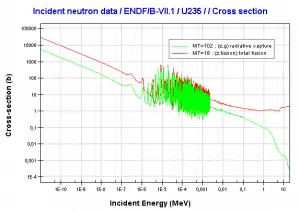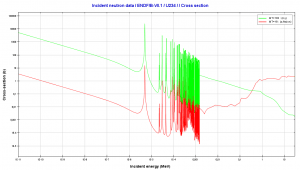Isotopes of Uranium
The main isotopes, which have to be considered in the fuel cycle of all commercial light water reactors, are: Naturally-occurring isotopes
- 238U. 238U belongs to the group of fertile isotopes. 238U decays via alpha decay to 234Th with a half-life of ~4.5×109 years. 238U occasionally decays by spontaneous fission with the probability of 0.000055%. Its specific activity is very low ~3.4×10-7 Ci/g.
- 235U. 235U belongs to the group of fissile isotopes. 235U is the only existing fissile nucleus from naturally occurring isotopes, and therefore it is a highly strategic material. 235U decays via alpha decay (thorium-231) into 231Pa with a half-life of ~7×108 years. 235U occasionally decays by spontaneous fission with a very low probability of 0.0000000072%. Its specific activity is very low ~2.2×10-6 Ci/g.
- 234U. 234U belongs to the group of fertile isotopes. 234U decays via alpha decay to 230Th with a half-life of 246 000 years. 234U occasionally decays by spontaneous fission with a very low probability of 0.0000000017%. Its specific activity is much higher ~0.0063 Ci/g.
Artificial isotopes
- 233U. 233U belongs to the group of fissile isotopes. It is produced by radiative neutron capture in nuclear reactors containing thorium fuel. 233U decays via alpha decay into 229Th with a half-life of 159 200 years. 233U occasionally decays by spontaneous fission with a very low probability of 0.000000006%. Its specific activity is ~0.0098 Ci/g.
- 236U. 236U is neither a fissile isotope nor a fertile isotope. 236U is fissionable only by fast neutrons. Isotope 236U is formed in a nuclear reactor from fissile isotope 235U. 236U decays via alpha decay to 232Th with a half-life of ~2.3×107 years. 236U occasionally decays by spontaneous fission with a very low probability of 0.00000009%. Its specific activity is ~6.5×10-5 Ci/g.
- 232U. 232U belongs to the group of fertile isotopes. 232U is a side product in the thorium fuel cycle, and also this isotope is a decay product of 236Pu in the uranium fuel. 232U decays via alpha decay to 228Th with a half-life of 68.9 years. 232U very rarely decays by spontaneous fission. Its specific activity is very high, ~22 Ci/g, and its decay chain produces very penetrating gamma rays.
Comparison of total fission cross-section and cross-section for radiative capture.
 Uranium 235. Comparison of total fission cross-section and cross-section for radiative capture.
Uranium 235. Comparison of total fission cross-section and cross-section for radiative capture. Uranium 234. Comparison of total fission cross-section and cross-section for radiative capture.
Uranium 234. Comparison of total fission cross-section and cross-section for radiative capture. Uranium 233. Comparison of total fission cross-section and cross-section for radiative capture.
Uranium 233. Comparison of total fission cross-section and cross-section for radiative capture. Uranium 236. Comparison of total fission cross-section and cross-section for radiative capture.
Uranium 236. Comparison of total fission cross-section and cross-section for radiative capture. Uranium 232. Comparison of total fission cross-section and cross-section for radiative capture.
Uranium 232. Comparison of total fission cross-section and cross-section for radiative capture.
Source: JANIS (Java-based Nuclear Data Information Software); The JEFF-3.1.1 Nuclear Data Library Uranium 238. Comparison of total fission cross-section and cross-section for radiative capture.
Uranium 238. Comparison of total fission cross-section and cross-section for radiative capture.
 Uranium 235. Comparison of total fission cross-section and cross-section for radiative capture.
Uranium 235. Comparison of total fission cross-section and cross-section for radiative capture. Uranium 234. Comparison of total fission cross-section and cross-section for radiative capture.
Uranium 234. Comparison of total fission cross-section and cross-section for radiative capture. Uranium 233. Comparison of total fission cross-section and cross-section for radiative capture.
Uranium 233. Comparison of total fission cross-section and cross-section for radiative capture. Uranium 236. Comparison of total fission cross-section and cross-section for radiative capture.
Uranium 236. Comparison of total fission cross-section and cross-section for radiative capture. Uranium 232. Comparison of total fission cross-section and cross-section for radiative capture.
Uranium 232. Comparison of total fission cross-section and cross-section for radiative capture.